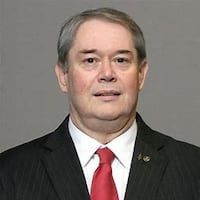Gov. DeWine made infrastructure grant presentations in Lebanon, Vandalia and in Fayette. He said the money was federal funding made available to the state and that his office and the Ohio General Assembly wanted to earmark these funds to help improve clean water systems and wastewater treatment plants and to replace lead pipes.
At Lebanon’s 50-year-old Glosser Road wastewater pumping station, DeWine announced a $4 million grant to replace the pumping station with a new facility. The city’s sanitary sewer waste comes to the facility and is pumped five miles to the city’s wastewater treatment plant on Mason-Morrow-Milgrove Road, according to City Manager Scott Brunka.
“These grants focus on smaller water plants and are an extension of the H2Ohio program,” DeWine said.
While $93 million in projects were announced on Tuesday, DeWine said there will be two more rounds and that the total amount being distributed through the three rounds will be about $250 million. He said the state is reinvesting in communities through its infrastructure and that every county in the state will receive some funding from this program.
“If we have good infrastructure, that means we can grow,” DeWine said.
Vice Mayor Mark Messer said this project “is super-important for Lebanon.” Messer said it’s challenging for small communities to continue making upgrades to their infrastructure systems while avoiding rate increases.
Brunka said the city had been put on notice to address the 50-year-old pumping station. He said during some heavy rains there was overflow from the 4-million-gallon flow equalization tank that went into the Turtle Creek, which drains into the Little Miami River, a federal and state-designated scenic river. Brunka said the large equalization tank was built in 2004 to prevent overflows.
“It’s helped, but it hasn’t solved the problem,” Brunka said. “It’s undersized and outdated. During heavy rain events, it overflows.”
Brunka said the city has been working on replacement plans for the past two years and hopes to begin construction on the new $9.8 million pumping station next year. He said city will be looking at obtaining a low-interest EPA water pollution control loan and other grants to cover the rest of the project costs.
Earlier in the day, DeWine stopped in Vandalia to present a $2.4 million grant for a sanitary sewer improvement project there. The city of Vandalia jointly owns and operates the Tri-Cities North Regional Wastewater Authority with Huber Heights and Tipp City.
Rich Hopkins, Vandalia’s communication director, said the plant uses 30-inch sewer lines to bring wastewater from Vandalia and Tipp City to the treatment plant located near Huber Heights. One of the lines that runs through the Five Rivers MetroPark at the Taylorsville Dam has collapsed and is in need of repair.
About the Author
